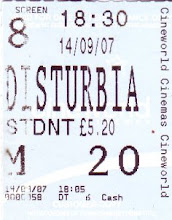It was one of the most fantastically enthralling and incredible films i have ever seen - definitely the best thriller - so therefore i wanted to study it somehow and i decided to apply the narrative theories to it:
Binary Opposites
There are mainly only opposite from the genre psychological/courtroom thriller
Sanity vs. Insanity - very very important
Innocent vs. Guilty - typical of courtroom thrillers
Right vs. Wrong - always a sense of this with murders
Action/Enigma Codes
There isn't really a sense of action codes playing much of a part in this film - obviously events lead to other events and there are of course examples of it, but the film isn't particularly suspenseful for the large part so it doesn't keep the audience wondering and guessing.
Although one very good example is in the final courtroom scene when the audience guesses that the Gere is trying to get 'Roy' to come out of Norton and it keeps you on the edge of your seat because you really want it to happen - you want to know if his heckling will lead to Norton's other personality coming out.
There are a lot more enigma codes than action, they don't create instant suspense but more of an ongoing questioning int he audience's mind:
- Who killed the Archbishop?
- If it was Aaron then why?
- What are the reasons behind his schizophrenia?
The brilliant thing about this film is that even thought there are lots of questions, the audience thinks that they have it all sussed out right up until the last scene when the biggest of twists is unveiled - one which i don't think anyone would have see coming. It turns out that 'Aaron' never really existed, the personality of 'Roy' is who he actually is, and he just pretended to have schizophrenia to get away with the murder.
Narrative Structure
1.) Equilibrium - The Archbishop is alive and well
2.) Disruption - He is brutally murdered/Aaron is blamed
3.) Discovery of event - Murder is overheard by postman
4.) Attempt to repair - Trying to bring killer to justice/free Aaron
5.) New equilibrium - It is discovered who murdered him/also that he wasn't such a saint as he sexually abused the altar boys
The new equilibrium is certainly different because lots of secrets have come out - the archbishop was a sexual abuser/also that he died to begin with/Aaron is no longer a sweet altar boy.
Folk Tales Character Types
This film is a good example of when directors/writers mess with the conventions of characters - and therefore they become very obvious to the audience.
Due to the fact that the discovery of Aaron's non-existent schizophrenia changes the dynamic of the film and the audience's perceptions so much, there are 2 different sets of the 8 character types established; before we discover Aaron was lying, and after.
Before
- The Villain: the prosecutor
- The Hero: there are 2 - the Lawyer (Vail) and Aaron
- The Donor: the second altar boy who tells of the sex tape
- The helper: Vail's assistant working at his firm
- The princess: there isn't really a princess here, unless you count the prosecutor who seems to have a past with Vail
- Her father - as a courtroom thriller there isn't so much a reward for anyone except justice, so perhaps the judge is the father here
- The Dispatcher: in this case, is the lawyer's craving for fame that sends him on his way
- The false hero: there isn't one just yet.
After
- The Villain: Aaron - because he really did commit the murder in a sane state of mind
- The Hero: the Lawyer - because he trusted + believed (and clearly Aaron is no longer a hero)
- The princess: there isn't really a princess here, unless you count the prosecutor who seems to - The false hero: is Aaron also as we are lead to believe he is a hero for all except 5 minutes of the film
The hero, turned false hero at the end, really messes with the audiences head and indeed the real hero (Vail). I think this rule is the one which is most often broken by directors/writers because it is the most effective at shocking/thrilling and making a great statement.

No comments:
Post a Comment